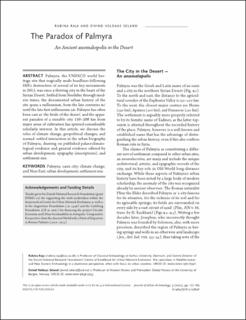| dc.contributor.author | Raja, Rubina | |
| dc.contributor.author | Seland, Eivind Heldaas | |
| dc.date.accessioned | 2022-05-02T10:52:45Z | |
| dc.date.available | 2022-05-02T10:52:45Z | |
| dc.date.created | 2022-04-28T11:17:45Z | |
| dc.date.issued | 2022 | |
| dc.identifier.issn | 2736-2426 | |
| dc.identifier.uri | https://hdl.handle.net/11250/2993620 | |
| dc.description.abstract | Palmyra, the UNESCO world heritage site that tragically made headlines following ISIS’s destruction of several of its key monuments in 2015, was once a thriving city in the heart of the Syrian Desert. Settled from Neolithic through modern times, the documented urban history of the site spans a millennium, from the late centuries bc until the late first millennium ad. Palmyra has often been cast as ‘the bride of the desert’, and the apparent paradox of a sizeable city 150-200 km from major areas of cultivation has spurred considerable scholarly interest. In this article, we discuss the roles of climate change, geopolitical changes, and nomad-settled interaction in the urban biography of Palmyra, drawing on published palaeoclimatological evidence and general evidence offered by urban development, epigraphy (inscriptions), and settlement size. | en_US |
| dc.language.iso | eng | en_US |
| dc.publisher | Brepols | en_US |
| dc.rights | Navngivelse-Ikkekommersiell 4.0 Internasjonal | * |
| dc.rights.uri | http://creativecommons.org/licenses/by-nc/4.0/deed.no | * |
| dc.title | The Paradox of Palmyra: An Ancient anomalopolis in the Desert | en_US |
| dc.type | Journal article | en_US |
| dc.type | Peer reviewed | en_US |
| dc.description.version | publishedVersion | en_US |
| cristin.ispublished | true | |
| cristin.fulltext | original | |
| cristin.qualitycode | 1 | |
| dc.identifier.doi | 10.1484/J.JUA.5.129848 | |
| dc.identifier.cristin | 2019752 | |
| dc.source.journal | Journal of Urban Archaeology (JUA) | en_US |
| dc.source.pagenumber | 177-189 | en_US |
| dc.identifier.citation | Journal of Urban Archaeology (JUA). 2022, 5, 177-189. | en_US |
| dc.source.volume | 5 | en_US |

